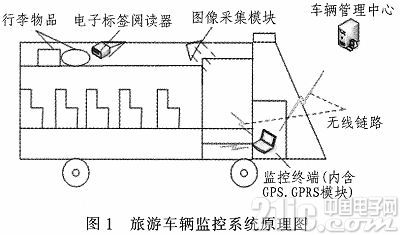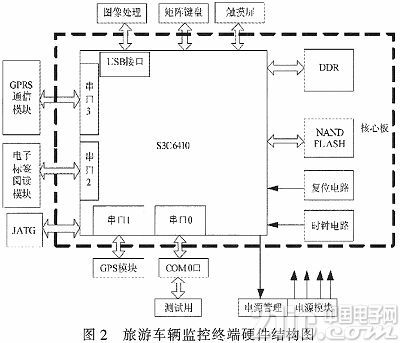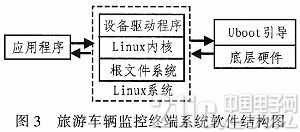With the development of the economy and the improvement of people's living standards, the tourism industry is booming. The monitoring and management of tourist vehicles has become a problem that cannot be ignored. In recent years, a variety of tourism vehicle supervision systems have emerged. These systems have completed the monitoring and management of the tourist vehicles to ensure the normal operation of the vehicles; but they do not involve the identification and certification of passengers, and it is difficult to obtain accurate passenger information; at the same time, it is difficult for the travel company to obtain the running status of the tourist vehicles in real time. And accurate location.
This article refers to the address: http://
Aiming at the shortcomings of existing tourism vehicle monitoring system, and considering the characteristics of embedded system software and hardware tailoring, this paper proposes a design scheme of tourism vehicle monitoring system based on ARM-Linux embedded system. The embedded embedded Linux is used as the operating system of the travel vehicle monitoring terminal; the PCA-based face recognition algorithm is used to identify and verify the passenger identity; the RFID technology is used to archive the luggage item information carried by the passenger; The real-time location information of the vehicle; the communication between the tourist vehicle and the dispatch center is realized by the GPRS method. The monitoring system can monitor the running status of the tourist vehicle in real time to ensure the personal and property safety of the passenger.
1 The composition and function of the tourism vehicle monitoring system
The tourism vehicle monitoring terminal is mainly composed of an image acquisition module, an electronic tag reader, a GPRS module and a GPS module, and its working principle is shown in FIG. 1 .

The image acquisition module completes the collection of the passenger face image and performs corresponding image preprocessing to obtain the facial image information of the passenger. When the passenger gets into the car, the facial image of the passenger is collected and matched with the pre-stored information. If the information is correct, the number of people is counted, and if the identity information is incorrect, a voice alarm is issued. This can automatically count the number of passengers at tourist attractions, avoiding the phenomenon of lost passengers, while reducing the workload of the staff.
The electronic tag reader reads the information of the passenger carrying the baggage, and stores and electronically archives the read data. When the passenger's baggage is found to be missing, the system will send a real-time voice prompt to remind the passenger to carry his luggage.
The GPS module mainly uses the global satellite positioning system to locate the tourist vehicle in real time, and displays related information on the vehicle terminal, and transmits the location information of the tourist vehicle to the vehicle management center of the travel agency through the GPRS module.
The GPRS module mainly transmits the running state of the vehicle, the geographical location information of the traveling vehicle and the safety status of the vehicle personnel to the vehicle management center through the mobile communication network, and simultaneously transmits the scheduling information of the vehicle management center to the traveling vehicle to the traveling vehicle, thereby realizing Scheduling and management of tourist vehicles.
2 Hardware design of tourism vehicle monitoring system
The hardware platform of the tourism vehicle monitoring system is mainly composed of the core board of Samsung S3C6410 processor, image acquisition module, LCD display module, GPS positioning module, GPRS wireless communication module and corresponding communication interface module. The hardware system structure is shown in the figure. 2 is shown.

This system uses Samsung's S3C6410 as the system microprocessor. The S3C6410 is a low-power, cost-effective RSIC processor from Samsung that is based on the ARM11 core (ARM1176JZF-S). The S3C6410 provides optimized hardware performance for 2.5G and 3G communication services with built-in powerful hardware accelerators including motion video processing, audio processing, 2D acceleration, display processing and scaling: integrated with an MFC (Multi-Format video Codec) support MPEG4/H.263/H.264 codec and VC1 decoding, can provide real-time video conferencing and NRSC and PAL TV output; in addition, the processor built a 3D accelerator with the most advanced technology, support OpenGLES 1.1/2.0 and D3DMAPI enable 3D acceleration of 4M triangles/s; at the same time, S3C6410 includes an optimized external memory interface that meets the data bandwidth requirements in high-end communication services. The stable frequency can reach 400M Hz, and internal controllers such as USB, UART, SDRAM and FLASH are integrated to match the peripheral network and keyboard and other devices, which can easily realize the system expansion.
The system is composed of two K4X51163PC chips cascading to form a 128M 32-bit wide DDR memory, and the DDR data transmission bus frequency can reach 266MHz. At the same time, the NAND Flash of K9G8G08U0A chip is used as the external storage system, the storage capacity reaches 1G, mainly stores the bootloader, Linux kernel and root file system; the special boot program of Nor Flash memory storage of AM29L160DB is selected. There are 4 serial ports on the circuit board, including one five-wire RS-232 level serial port and three three-wire TTL level serial ports. The serial port communication uses MAX202E, and serial port 0 is mainly used for testing. The serial port 1, 2, 3 can be respectively connected with the GPS positioning module, the electronic tag reader and the GPRS wireless communication module to realize the vehicle positioning, the electronic tag data reading and the wireless communication function with the vehicle management center. The USB interface uses the AT43301 chip to divide the USB into one host and one slave interface. The system's USB camera uses VIMICRO's VC0326 sensor chip, which features high pixel, built-in support for MIC and USB2.0. The digital camera directly captures the digital image signal, avoiding the analog/digital conversion process of the additional video signal. USB's plug-and-play feature makes device plug-in connections more convenient and faster.
3 Software component design of tourism vehicle monitoring system
3.1 Software design idea of ​​monitoring system
The development of embedded software system mainly includes three parts: system boot loader (BootLoader), embedded Linux kernel customization, root file system and application design. The software structure of the entire monitoring terminal system is shown in Figure 3.

The BootLoader uses U-Boot developed by the company to boot the operating system. Because U-Boot has full support for the S3C6410 processor platform, it can be applied to specific design projects with a small amount of modification.
The embedded operating system adopts the newer version of Linux-3.0.1. The kernel optimizes the processing of video and large data volume. The kernel also has a better kernel scheduling strategy, and the real-time performance is greatly improved.
The root file system mainly implements customization of the shell command set, preparation of system configuration scripts, and generation and addition of related embedded library files. Considering the limited Flash resources of the embedded system, this design scheme uses the mkcramfs tool to create a compressed root file system to save system resources.
3.2 Detection and recognition of face images
In the tourism vehicle monitoring system, the detection and recognition of face images is the key technology of design. Here, principal component analysis (PCA) is mainly used to complete the automatic recognition of face images. Because the classical PCA method extracts the global features of the image, it is affected by the illumination conditions and facial expression changes, which makes the recognition effect less than ideal. In this design, the image is preprocessed by gamma transform, so that the influence of uneven illumination on image recognition is reduced, and it is convenient to identify the face image by PCA method.
The process of recognizing face images mainly includes face database creation and recognition of input faces. The process of establishing the face database is as follows: First, the system loads the face detector into the system to initialize the system; then takes the image from the camera, and when the face image is detected, the face area is scaled; Then the person's face image is preprocessed and then stored in the face database. The recognition process is as follows: First, the face database is trained, and then the detected face is extracted, and the classifier is used for recognition.
3.2.1 Preprocessing of face images
The gamma transform is a commonly used nonlinear transform whose basic expression is s=crγ, where c and γ are normal numbers, r represents the gray value of the input image, and s represents the gray value of the output image. When γ>1, the high gray value of the narrower range of the input is mapped to a wider output value, and the contrast of the high gray area of ​​the image is enhanced; when γ<1, the low gray value of the narrow range of the input is input. Mapped to a wider range of output values, the image's low gray area contrast is enhanced; when γ = 1, it is a linear transformation, without changing the original image. When the γ value increases, the output gradation s increases rapidly as the exponent increases, but when the exponent reaches 2 or higher, the curve becomes an approximate perpendicular and the resulting image is almost completely black. . Therefore, the value of r should be between 0 and 1.
3.2.2 Face recognition
The PCA method is a commonly used method in face recognition. It uses the K-L transform theory to find a set of orthogonal vectors in the original face space from the global perspective of the face image, and forms a new person. Face space, to achieve the purpose of dimensionality reduction.
Let xi∈Rn(i=1,2,...,m) be M n-dimensional observation samples, X=(s1, s1,..., s1)T is the observation sample matrix, and the mean of the overall samples is:

3.3 System Application Design
The functionality of the system is done by the application. In order to save system resources and effectively utilize the CPU, the system uses multi-process technology to realize the scheduling of system tasks. When the embedded system starts, first load the device driver, complete the initialization of the device, and then call the application to complete the following functions:
1) Collection of information data
Acquire image signals (camera with USB interface) through USB interface; collect vehicle positioning information (GPS module with serial port) and passenger information (electronic tag reader with serial port) through serial port.
2) Information processing module
The collected images are identified and processed to confirm the identity of the passengers; the vehicle is GPS-positioned; the passenger's luggage items are registered and associated with the passengers.
4 Conclusion
The system adopts ARM11 microprocessor as the main control hardware platform, realizes the collection of face images by using the camera module with USB interface, and uses PCA algorithm to identify the face; using the electronic tag reader with serial port to the passenger luggage items Registration is carried out and associated with the passenger; the GPS module with serial port is used to realize the positioning of the vehicle; the GPRS module is used to transmit the control information of the passenger vehicle to the remote tourism vehicle monitoring center via the wireless network. The tourism vehicle monitoring system is based on the development of the Linux operating system. Thanks to the advantages of the open source code of the Linux system, the development cost can be greatly reduced. The use of embedded systems to complete the detection and monitoring of vehicles, people and property is a new development direction of intelligent management systems, and has broad application prospects.
576mm*1728mm LED Poster Display
LED Digital Poster,LED Display Poster,Poster LED Screen,Digital LED Poster Price
Shenzhen Uhled Technology Co., Ltd. , https://www.uhled.com